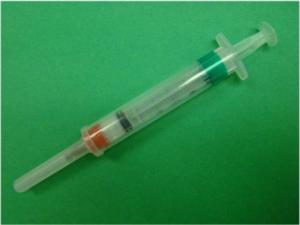|
OBGYN Skills Lab
|
|||||||||
|
HPV Immunization Video HPV, or Human Papilloma Virus, is a common skin virus with more than 100 subtypes. Most of these subtypes are annoying, but not dangerous, causing warts on the hands or feet. Certain subtypes cause warts to grow in the genital area, or in unusual circumstances, in the mouth. Other subtypes are more dangerous and are associated with cancer of the cervix. One vaccine designed to prevent genital warts and cervical cancer is called Gardasil®. It is given as a series of three injections over 6 months. It is currently recommended for 11 and 12 year old girls, as well as women ages 13 to 26 who have not yet been vaccinated or completed the vaccine series. Click Here to watch the video. Begin by washing your hands and putting on protective gloves. Open the box and remove the vial. Check to make sure it is the correct vaccine, with a unit dose of 0.5 ml. Check the Lot Number and write it down. Check the expiration date and write it down. Inspect the contents of the vial. The vaccine is a white suspension. The rubber stopper should be smooth, without defects or leaks. The box also contains detailed directions. You should read the directions carefully if you are not familiar with this procedure. The syringe used for this procedure should be an appropriate size for the 0.5 ml dose. A 3 cc syringe works well. The 20 to 22 gauge needle should be one inch to 1.5 inches in length. Cleanse the rubber stopper with an antiseptic, such as alcohol. Draw 0.5 ml of air into the assembled needle and syringe. Then insert the needle straight down into the vial. Inject the vial with the 0.5 ml of air. Don't over-inject or the air pressure may create leaks in the vial. Invert the vial and draw the vaccine into the syringe. Clear any air from the syringe and adjust the dose to exactly 0.5 ml. Withdraw the needle and if you are not going to immediately administer the vaccine, safely re-cap the needle This intramuscular injection is usually given in the deltoid muscle of the shoulder. The deltoid muscle is shaped like an upside down triangle. The best injection site is in the center of the muscle, usually about three fingerbreadths down from the shoulder joint. Other possible injection sites include the upper, outer quadrants of the gluteus maximus muscle of the buttocks, or the vastus lateralis muscle of the anterior lateral thigh. Identify the injection site. Cleanse the skin with a disinfectant such as alcohol. Some gentle finger flicks before the injection helps block some of the sensory nerves from the site and will reduce the discomfort of the needle insertion. Use your non-dominant thumb and forefinger to support the muscle. Holding the syringe like a dart, insert the needle directly into the muscle. Use a smooth, rapid technique to minimize patient discomfort. Aspirate before injecting to make sure you're needle is not in a blood vessel. Then slowly inject the vaccine. After removing the needle, wipe away any blood from the injection site and cover with a bandaid. Localized mild to moderate pain at the injection site is common in the first few days following the injection. Redness and swelling are less common. Serious side-effects are rare. Remember to schedule the patient for her followup injections. |
||||||||
|
This information is provided by The Brookside Associates, a private organization, not affiliated with any governmental agency. The opinions presented here are those of the author and do not necessarily represent the opinions of the Brookside Associates. For educational simplicity, only one method is usually shown, but many alternative methods may give satisfactory or superior results. This information is provided solely for educational purposes. The practice of medicine and surgery is regulated by statute and restricted to licensed professionals and those in training under supervision. Performing these procedures outside of that setting is a bad idea, is not recommended, and may be illegal. The presence of any advertising on these pages does not constitute an endorsement of that product or service by the Brookside Associates. C. 2010 All Rights Reserved |
|||||||||
 This is the Archived Desktop Edition.
This is the Archived Desktop Edition. 